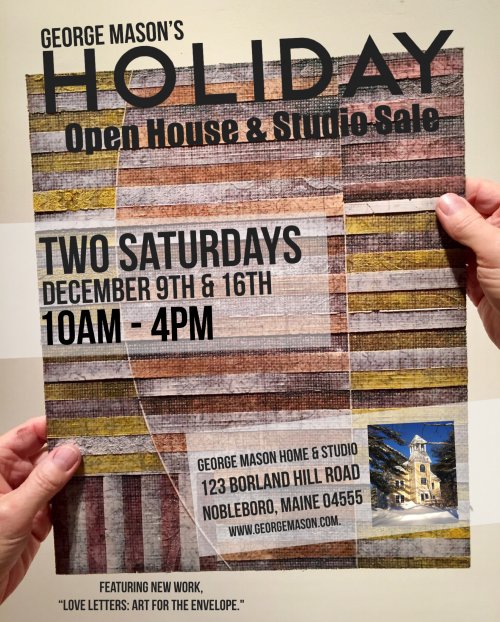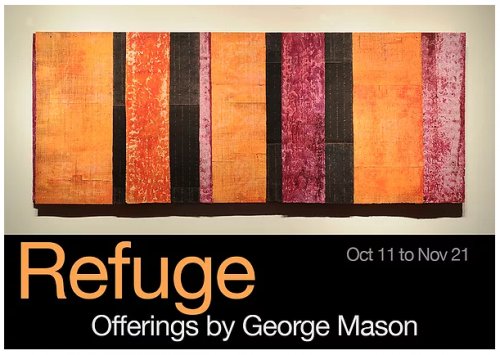
George Mason, “Untitled With Spire on Muted Violet,” Hydrocal, plaster, burlap, casein, encaustic, 20-3/4″ x 40″ Photos courtesy of Greenhut Galleries
It’s been a long time since I’ve seen a sculpture show that was genuinely exciting. So, thank you, Greenhut Galleries, for rousing me from my jaded lethargy with “Objects/Objectivity” (through Mar. 6), the brainchild of Greenhut staffers (and artists) Roy Germon and Dean McCrillis.
The exhibition’s excitement is due not only to the actual work on display, which is by three very different Maine artists: Nobleboro-based George Mason, Jefferson-based John Mess and Waterville-based Oliver Solmitz. The exhilaration has to do with the dialogue that ricochets around the room among the works themselves, stimulating a constant push-pull between order and chaos, remoteness and immediacy, serenity and explosive energy.
Mason begins his multistep process by soaking burlap with Hydrocal plaster, a medium usually used to make molds, which gives the material some solidity and heft without robbing it of its pliability. At some point, encaustics and casein paint – a water-based medium used as far back as prehistoric cave paintings – also enter the process, as do stencils and various tools Mason employs to create raised patterns on the resulting panels. Then he cuts sections of variously patterned panels and begins collaging them together.
“I am seeing that light and shadow, color and texture, can nourish without telling a story,” Mason says in his artist statement. And, indeed, his palpably meditative process elicits a sense of peace and calm in the viewer. The repetition of pattern, which can also feel like primeval rhythms of the earth and universe, have an effect similar to that of the music of Philip Glass. And the use of casein paint also connects these sculptures through millennia to the dawn of human existence, adding to their quality of timelessness and contemplation.
Yet, like Glass, the repetition, as well as the predominance of structure in Mason’s works, can also make them feel coolly controlled and even slightly remote. One thing impossible to glean from viewing them in a gallery is their elasticity. The fact that they can be animated by air currents would go a long way toward countering that coolness. Additionally, though Mason’s statement indicates the absence of narrative, story is nevertheless implied in certain titles, like “Sentinels” and “Untitled Spire on Muted Violet.” These imbue what we might have perceived as abstract assemblages of shapes with a storyline. It becomes impossible to look at those shapes and not read them as sentinels or a spire, bringing form to the formlessness of meditation.
On the polar opposite of this perceptual spectrum is Mess. Order and structure are not in this artist’s lexicon. Instead, his work is thoroughly experimental and radiates an explosive, chaotic energy. Former Press Herald art critic Daniel Kany wrote very perceptively about Mess’s work, likening it to three-dimensional abstract expressionist paintings. To this I would add that the freestanding work might also call to mind Richard Chamberlain’s crushed-car sculptures, with their compressed accretion of layers.
AdvertisementThey are made from recycled ceramic materials such as slop clay, discarded mystery glazes and broken pieces of former work. But they might also contain dirt, ash left from crumpled newspaper incinerated in the kiln and any manner of other materials. Go-for-broke experimentation and unpredictability are integral to these works. Mess also acts like an action painter a la Jackson Pollock, using his whole body in the production of the sculptures and pouring glazes over them in painterly drips. This physicality virtually erupts from the work.
References to Maine’s land and water bodies are clear. “Core II” and “Core III” resemble nothing if not stratified geological forms. These are Mess’s strongest pieces in the show. Unfortunately, they sit on a pedestal that is pushed against the perimeter of the room rather than standing in the middle of the space to be viewed in the round. Germon explained that it was a practical necessity of the small gallery, a precautionary measure against tipping over. That’s fair. But one of the aims of sculpture is to claim its own presence within a space and, by so doing, define the space around it. This is impossible to accomplish when one side of it meets the implacability of a wall.
A series of works called “Waterstruck Slab” hang on the wall and can appear as aerial maps (No. 40, No. 14), waves (No. 28), caked earth (No. 24, No. 25) and sedimentary rock (No. 21). While they are certainly interesting and beautiful, they seem closer to decorative glazed tiles and, so, do not communicate the expressive power of the “Core” sculptures. In this vein, I prefer “Large Traces Slab No. 9,” which has the compacted density of igneous rock. It’s a measure of the steady centeredness of Mason’s work that it is not outshouted by the Mess sculptures. Instead, that oppositional tension electrifies the air between them.

Jonathan Mess, “Waterstruck Slab No. 40,” various reclaimed ceramic materials, 16.5″ x 7.5″ x 1″ Photo by Kate Mess
The “middleman,” so to speak, is Solmitz. His sculptures display clear affinities to his architectural education and, specifically, Brutalism, the movement of fortress-like steel and poured-concrete buildings promulgated first by Le Corbusier and later by Louis Kahn, Paul Rudolph and others in the 1950s and ’60s. Some works, such as “Untitled 5” and “Untitled 9,” hark even further back, to the 1920s Suprematism of Kasimir Malevich and/or the Constructivism of El Lissitzky and Vladimir Tatlin.
They appear exceedingly rational at first, seeming to calm the waters stirred up by Mason and Mess from their respective polarities. Yet spending time with them rewards us with deeper meaning. Two-dimensional plywood sculptures “Untitled 7” and “Untitled 6” are resolutely architectural, appearing almost like maquettes of buildings to be constructed. So are steel works like “Untitled 2,” “3” and “4,” though their connection to actual buildings is less obvious, a fact that makes them stronger in my mind, as pure sculpture.
What all of them have in common is the way they play with light and shadow. Pendulous volumes in “6” and the roof and walls of “7” cast shadows in the interiors of these “buildings.” The steel works do something similar. However, since the plywood works suggest buildings yet to be built, this play of light and shadow is mostly just interesting. The steel works, on the other hand, emanate a melancholy we associate with abandoned structures. This is partly due to the oxidized quality of the steel, which evokes long-forsaken industrial buildings. Unlike the plywood works, these reverberate with the poignancy of empty rooms that once thrummed with human life and activity.
AdvertisementIn a way, the silence of these rooms returns us to the contemplative quiet of Mason’s work. I have talked about each artist’s sculptures individually. But Germon and McCrillis have mixed them up all around the gallery, which is what arouses our excitement. They appear engaged in a nonstop dialectical exchange, making us feel as though we’ve stumbled into the middle of a heated philosophical discussion. And, in a way, we have.
The show left me with one selfish wish, too – that Mess and Solmitz start working in monumental proportions. It is thrilling to think what it would be like to come across Mess’s “Core” sculptures or something like Solmitz’s “Untitled 4” at 50 or 100 times their size. I can feel a sharp, shocked inhalation and a subsequently exhaled gasp just thinking about it.
Jorge S. Arango has written about art, design and architecture for over 35 years. He lives in Portland. He can be reached at: [email protected]





